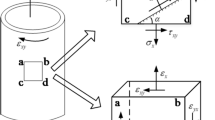Abstract
An energy-based fatigue-life prediction framework for the determination of full-life, remaining-life, and critical-life of in-service structures subjected to torsional-shear loading has been developed. This framework is developed upon the existing foundation of energy-based fatigue models crafted for the axial, uniaxial bending, and transverse-shear loading cases, which state: the total strain energy density accumulated during both a monotonic event and a cumulative cyclic process is the same material property. The modified energy-based torsional-shear fatigue-life prediction framework is composed of the following entities: (1) the development of a torsional-shear fatigue testing procedure capable of assessing strain energy density per cycle in a pure shear stress state and (2) the determination of the remaining-life and critical-life of in-service aluminum (Al) 6061-T6 structures subjected to shear fatigue through the application of the energy-based prediction method. Experimental data was shown to be affected by load-frame misalignment which was estimated and successfully incorporated into the validation results. Close correlation between adjusted experimental results and the full-life and critical-life predictions stemmed from a 3-to-2 shear-to-axial biaxial loading assumption, which was supported by crack path comparisons. Results of the study effectively demonstrated the versatility of the energy-based lifing method.















Similar content being viewed by others
Abbreviations
- E :
-
Young’s modulus
- G :
-
shear modulus
- N :
-
cycles to failure
- N c :
-
critical cycles to failure
- p :
-
principal direction
- W :
-
strain energy density
- W cy :
-
strain energy density, one cycle
- W m :
-
strain energy density, monotonic curve
- γ :
-
shear strain
- γ c :
-
cyclic curve fit coefficient, shear
- γ cy :
-
cyclic shear strain
- γ m :
-
monotonic shear strain
- γ o :
-
monotonic curve fit coefficient, shear
- γ u :
-
shear strain at failure
- ε c :
-
cyclic curve fit coefficient, axial
- ε o :
-
monotonic curve fit coefficient, axial
- ε u :
-
axial strain at failure
- σ c :
-
cyclic curve fit coefficient, axial
- σ o :
-
monotonic curve fit coefficient, axial
- σ p :
-
stress in principal direction p
- σ u :
-
axial stress at failure
- τ :
-
shear stress
- τ a :
-
shear stress amplitude at mean radius of gage length
- τ c :
-
cyclic curve fit coefficient shear
- τ o :
-
monotonic curve fit constant shear
- τ pp :
-
2τ a
- τ u :
-
shear stress at failure
- τ y :
-
0.2% offset shear stress
References
Goodman J (1899) Mechanics applied to engineering. Longmans, Green, and Co, London
Hanstock R (1947) Damping capacity, strain hardening and fatigue. Proc Phys Soc 59:275–287
Feltner C, Morrow J (1961) Microplastic strain hysteresis energy as a criterion for fatigue fracture. J Basic Engineering 15–22.
Forrest P, Tapsell H (1954) Some experiments on the alternating stress fatigue of a mild steel and an aluminum alloy at elevated temperatures. Proc Inst Mech Eng 168:763–774
Enomoto N (1955) On fatigue tests under progressive stress. ASTM 55:903–917
Stowell E (1966) Energy criterion for fatigue. Nucl Eng Des 3:32–40
Scott-Emuakpor O, Shen M-H H, Cross C, Calcaterra J, George T (2007) Development of an improved high cycle fatigue criterion. ASME J Eng Gas Turbine Power 129:162–169
Scott-Emuakpor O, Shen M-H H, George T, Cross C, Calcaterra J (2008) An energy-based uniaxial fatigue life prediction method for commonly used gas turbine engine materials. ASME J Eng Gas Turbine Power 130:062504–1
Scott-Emuakpor O, Shen M-H H, George T, Cross C (2010) Multi-axial fatigue-life prediction via a strain- energy method. AIAA J 48:63–72
Ozaltun H, Shen M-H H, George T, Cross C (2010) An energy based fatigue life prediction framework for in-service structural components. Experimental Mechanics Published online (May 25 2010): 1–12.
American Society for Test and Materials (2008) ASTM E2207: Standard practice for strain-controlled axial- torsional fatigue testing with thin-walled tubular specimens. Book of Standards 03.01
Scott-Emuakpor O, George T, Cross C (2009) The effects on fatigue life of aluminum based on surface conditions. PHM Society Annual Conference
Laz P, Hillberry B (1998) Fatigue life prediction from inclusion initiated cracks. Int J Fatig 20:263–270
American Society for Test and Materials (2007) ASTM E466: Standard practice for conducting force controlled constant amplitude fatigue tests of metallic materials. Book of Standards 03.01
Dieter G (1986) Mechanical metallurgy. McGraw-Hill, Boston
Scott-Emuakpor O, George T, Cross C, Shen M-H H, Wertz J (2010) Validation of a multi-axial fatigue life prediction using maximum shear experimental results. ASME/IGTI Turbo Expo GT2010-22547
Letcher T, Shen M-H H, Scott-Emuakpor O, George T, Cross C (2011) An energy based critical fatigue life prediction method. ASME/IGTI Turbo Expo GT2011-45443
Socie DF, Marquis GB (2000) Multiaxial fatigue. SAE, Warrendale
Wu H, Yang C (1987) On the influence of strain-path in multiaxial fatigue failure. ASME J Eng Gas Turbine Power 109:107–113
Acknowledgements
The authors would like to thank the Dayton Area Graduate Studies Institute (DAGSI) for their financial support of this research, without which it would not be possible. Additionally, the authors would like to thank the Air Force Research Laboratory (AFRL), specifically the Turbine Engine Fatigue Facility (TEFF), for their financial support, facility and equipment access, and encouragement of this research.
Author information
Authors and Affiliations
Corresponding author
Rights and permissions
About this article
Cite this article
Wertz, J., Shen, MH., Scott-Emuakpor, O. et al. An Energy-Based Torsional-Shear Fatigue Lifing Method. Exp Mech 52, 705–715 (2012). https://doi.org/10.1007/s11340-011-9536-6
Received:
Accepted:
Published:
Issue Date:
DOI: https://doi.org/10.1007/s11340-011-9536-6




